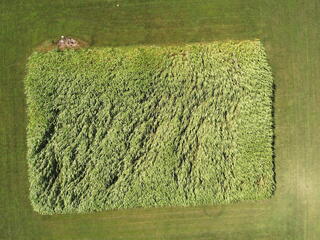Unlocking the mysteries of sorgham sugars

Discovery could help store more carbon as easily-fermented mixed-linkage glucan
The Science
Mixed-linkage glucan (MLG) is a type of sugar found in the cell walls of grasses. Scientists believe plants use MLG to store energy and provide support for cell walls. As they grow, plants like sorghum accumulate variable amounts of MLG in the cell walls. Some enzymes produce MLG and others, known as lichenases, break it down. Sorghum has one main enzyme that produces MLG, but scientists didn’t know which enzymes degrade it or understand why plants seem to break down a product while simultaneously producing it. In this study, scientists identified three sorghum lichenases that appear to “tune” MLG levels to meet different needs as plants grow.
The Impact
Crops like sorghum are a potential source of sustainable fuels and other chemicals traditionally made from petroleum, which are key parts of most plans to slow climate change. Energy sorghum can grow on marginal lands with little water or fertilizer, producing a lot of biomass while using its deep roots to store carbon in the soil. Compared to other components of the plant cell wall, MLG can be more easily converted into glucose, which microbes can ferment into alcohol. Understanding the role and mechanisms of MLG regulation could help scientists engineer bigger, faster-growing plants that store more carbon inside the cell walls and are more easily converted into biofuels.
Summary
Scientists with the Great Lakes Bioenergy Research Center analyzed protein sequences to identify three sorghum proteins similar to known lichenases in barley and a related grass called Brachypodium. Through in vitro experiments using barley and oat flours as well as a synthetic oligosaccharide, they showed that all three sorghum lichenases could digest MLG.
The researchers also tagged the sorghum lichenases with a fluorescent protein and transiently expressed them in tobacco leaf epidermal cells. The experiments showed the enzymes were secreted into the apoplast, the space between neighboring cells, consistent with the biological role of a lichenase that degrades MLG in the cell wall.
The study showed different types of cells produce enzymes to synthesize and degrade MLG at different stages of plant growth, matching the pattern of MLG abundance. Based on those results, the researchers proposed that MLG accumulates during early leaf development to provide sugars required for growth and to maintain high energy input to the growing cells.
Contact
Federica Brandizzi
Michigan State University
fb@msu.edu